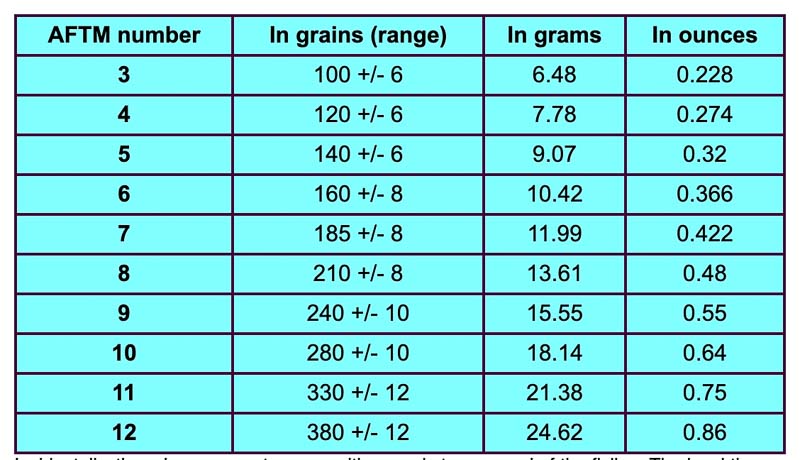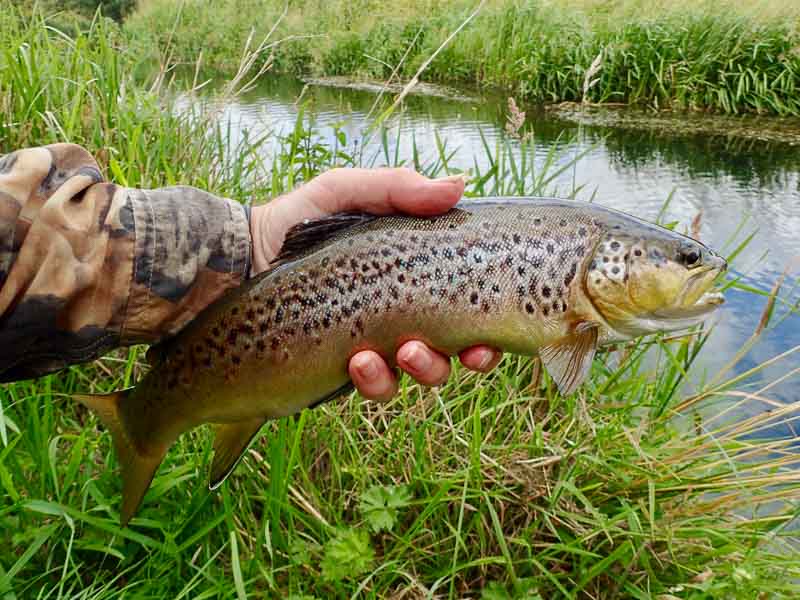Lazy fly line designs that are designed to 'not like your rod'
AFTM Fly Line system
Yes, that's right, the good old AFTM system. The emphasis is on old here; 1959 to be precise. Silk fly lines were measured by diameter, using the same systems that measured piano strings as it happens. When synthetic fly lines with tapered braided cores arrived there was a need to refresh the way they were designated. The AFTM system weighs the first 30' of the line and assigns a # weight. Here is the table:

When it was made fly lines were double taper, they had no shape other than a front taper. So, the AFTM system was relevant.
Weight versus Shape (taper)
"It is important to understand that it is the weight of the line that loads the fly rod, and that the diameter is of secondary importance. " This quote is taken from 'Evolution of the modern fly line." by Leon Chandler and may have been true with double taper floating fly lines but not weight forward lines with compound tapers. 99% of fly lines today are exactly that, compound taper weight forward lines of all lengths and shapes.Tom Bell says;
"I can, today, manipulate shape, specifically the rear taper and 'high point' of a line to change the perception of weight, more than the actual weight of a line. So, the diameter and changing nature of where those diameter changes are have more of an effect on fly rod load than weight alone."
For example, take a 40' head whose first 30' weighs 10g. The rear taper may start at 20' and last 20'. That line will feel a lot heavier than a line that also weighs 10g at 30' but whose head is 40' and whose rear taper only starts at 35' and lasts 5'. That's why modern fly line design requires we measure the entire head weight, in this case at 40'. Confusing? Yes, it can be which is why there is a need to overhaul / throw away the AFTM system entirely.
Fly Line Head Length
Here is the biggest and most shocking aspect of fly line design today;
Only Sunray change the head length and taper for each weight in a fly line range.
What does that mean? OK, take a RIO Gold. They make them in #3 to #9. and they are all 49'. I don't like exclamation marks but there should have been 5 of them after that statement. Why?
How long is a #3 rod? Typically anything from 6' to 9' right? Euro nymph rods are 10' and over but you wouldn't be buying a gold for those, so let's stay with good old overhead casting. A 49' head on a 7'9" #3 rod? Are you serious? Fly casting is a triangle, you have the caster, the head length of the line and the rod. If you have a short rod and a long 49' head, the triangle will be very 'flat'. Well, that flat bit means that you, the caster, has to move the short rod twice as far to keep that 49' of line from collapsing? Yes but we don't aerialise 49' on our 3 weights? OK, then why have it? What use is the thick 49' head doing dragging inside the guides and weighing down your £899 rod designed to be as fast and crisp as possible?
Why not dispense with a good 20' of that lumpy big head, swap it for light, thin running line that keeps your casts crisp and have a 29' head that is easily cast by normal people with more speed, precision and tighter loops?
Let's take that scenario to the other end of the spectrum. How many 7 weight fly rods do you own that are 7'6" like your 3 weight? None, that's how many. they are usually 10'. Now a 49' head on a 10' rod is perfect actually, if the taper is right, so the RIO gold at 49' for a 10' rod would be good. So, how come they make the same head length from #3 to #9 and never change the head length or taper? The only line I would buy out of the Rio Gold range is the 7 weight, because it's the right length for a 10' rod and all my 7's are 10'.
Because it's not enough to just change the head's length. As a line increases in weight or decreases in weight you have to re balance the line. On a 3 weight the running line and tip should be half the diameter of a 9 weight, which means that the head taper must change, sometimes only slightly to reposition the weight, to drag the thicker running line through the guides and kick bigger flies over at the front. Yes, that's right, why would there be a #3 line in a #9 line's range? You use a 9 weight for massive flies, a 3 for tiny dries, so the tapers must be completely different. Take a look on the Rio Gold page,
See any taper difference? None, so how does that work? It doesn't that's how and that's why fly lines 'don't work on my rod.'
The double hand formula
3 and half times the rod's length. There you go, we've been doing it for years, calculating not only head weight but head length. A scandinavian shooting head should be 3 to 3 and half times the rod length. So, you have a 13' rod, you need a head approx 39 - 45' long. That's the first consideration, now you think about weight. Why haven't line companies been asking this from their single hand counterparts? That's the biggest shock to me. Take your 10' rod. I would say 3 and half to 4 times the rod length placing the 49' Rio Gold bang on for a balanced flight. Simple. Learn the formula and if the company doesn't adjust according to that, swerve them. Here's what will happen if you don't.
The personification of fly lines
This is the funny bit. You must have heard it. I hear it from Master Instructors. "This rod doesn't like this line.' As though the line has a personality. Rubbish, it's because the company hasn't reverse engineered the line on that rod to understand what the rod is being used for. When I build a line, I build each weight like a new line, because I know what it will be used for and on what length / speed of rod. So, my 5 weight lines will be typically 35' long with short rear tapers and 9' front tapers because they deliver small to medium flies and the occasional sink tip work. How can you use a Rio Gold for a 9 weight and then use the same taper, only change the weight, on a 3 weight? You can't because the man whose fishing a 3 weight is using size 22 dries and the man using a 9 is using a completely different rod with different flies. Each line weight must be designed from the ground up to cater for the task. You don't use a 5 weight taper on a 9 weight line.
But no company, apart from mine, caters for that. And that's why fly lines don't "like' certain rods. Because they were designed with one weight and then just more weight was added, with no consideration to the purpose of the differing weights in that range, making the whole system unbalanced.
There is no such thing as bad tackle, only unbalanced tackle.
I say I make fly fishing tackle that needs tuning, like a guitar. Very few people can even tune these 'guitars' never mind play them. What do I mean? People think they can muddle through learning to cast, trying all different lines until they find one that works for them. What they don't understand is how to cast and the physics involved. They haven't found a line right for them, they have found a line that accidentally balances out there mistakes.
The number 1 mistake in fly casting. Too much overhang.
On all our lines there is an 'overhang marker.'
The overhang marker is a coloured section unique to each line in each weight. We have cast each weight of line and marked where the optimal point is to release the cast, for each weight, in every range, one by one. Here are the most common questions I here about overhang;
1. I can't make good casts every time. I can only make them now and again.
The overhang marker is a brightly coloured section between the head and running line that tells the caster when to release the forward cast. Many people slip line into their false casts, take too many false casts and then release. This means they have too much 'overhang' which is the amount of thin running line between the rod tip and the thicker belly of the line. The overhang marker prevents the caster slipping too much line into their false casts making perfect casts every single time.
2. Don't all lines have this?
No, most lines have a different coloured running line to the head. Or, some have a 'haul zone' which is a harder coating between the head and running line. Neither of these help in telling you when to release the forward cast. On every line, in every weight, the amount of overhang you can get away with is different. We have measured that section on each line in each weight and coloured the exact section. That is very different to a generic coating applied to all lines in all weights to prevent the line wearing out (haul zone.) And a different coloured running line only tells the user where the head starts, the user then has to figure out how much overhang they can get away with which is a very advanced skill, most professional casters have instinctively.
Summary
- Use the formula for head length
- Ask what the weight is of the entire head length
- Get a line with an overhang marker
































